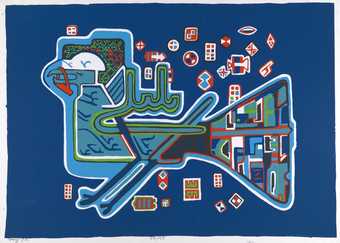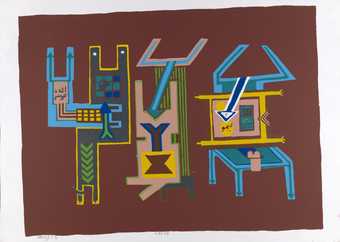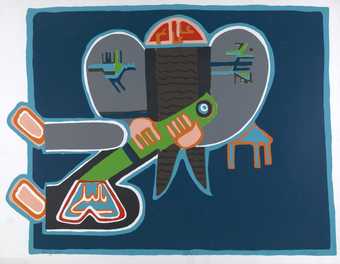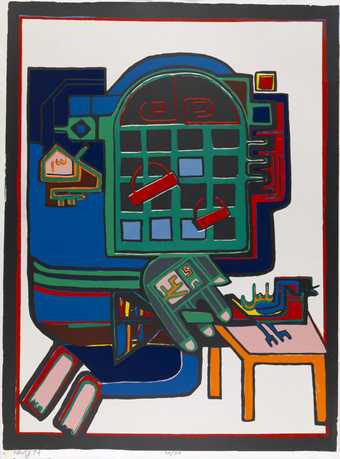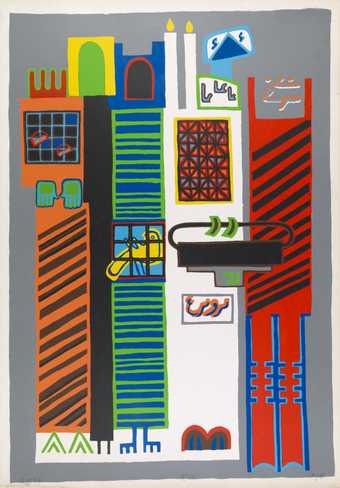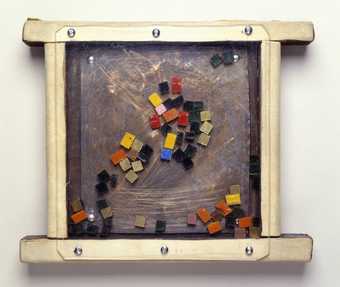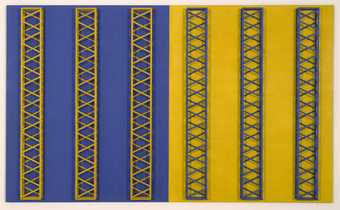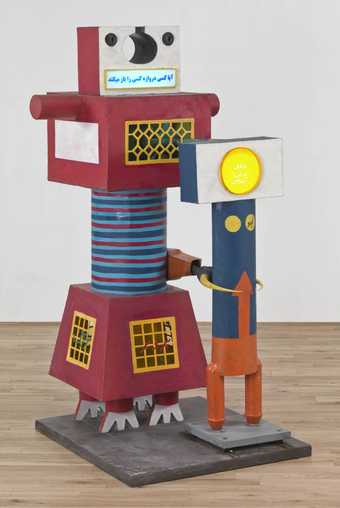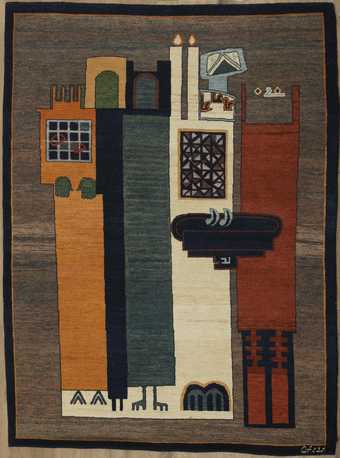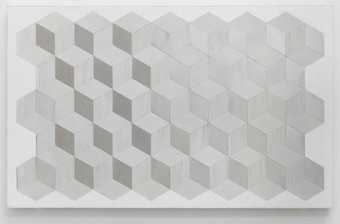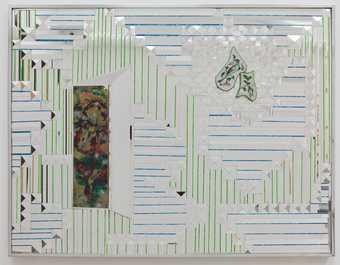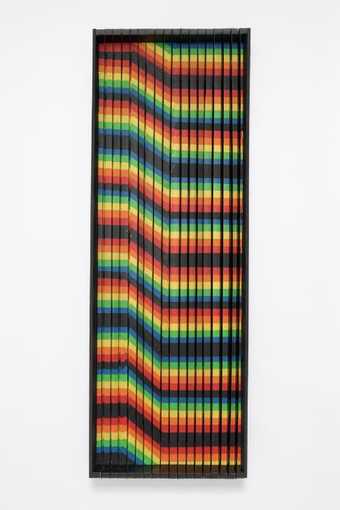
Not on display
- Artist
- Parviz Tanavoli born 1937
- Medium
- Wood, metal, feather, glass, plastic, paint and light
- Dimensions
- Object: 1095 × 712 × 225 mm
- Collection
- Tate
- Acquisition
- Purchased with funds provided by Maryam and Edward Eisler 2012
- Reference
- T13685
Summary
Cage, cage, cage is a mixed media wall-mounted work that depicts one small white bird and two different sized cages against a dark background. At the top of the work, the larger cage has a blue grid façade behind which illuminated fake grass can be seen. The bird is placed outside the top left corner of the second, smaller cage, which is an actual bird cage attached to the backboard. Cage, cage, cage was made in 1966 after Tanavoli returned from America, where he was greatly inspired by the pop art movement.
Tanavoli has often spoken about the influence of pop art on his work, primarily in relation to the vibrant colour choice of his earlier sculptural pieces. When he returned from the United States he decided to make a series of works using ‘aftabehs’, the watering cans used in the Iranian washroom. He exhibited these at the Iran America Society in Tehran in 1973, but was quickly forced to shut down the exhibition, as it caused controversy due to the association of these watering cans with lavatories. Tanavoli decided to change direction and conform to the tastes of the time by exploring the common themes that many artists of his generation were portraying. This imagery included the nightingale and flowers, which together represent love and relationships in Iranian culture and are the subjects of carpets, paintings and tapestries, as well as much Persian poetry. The theme of the bird is a repeated subject in Tanavoli’s work. The bird inside or outside of the cage can be interpreted in various ways, either as a political metaphor for social and cultural repression, or as a literal representation of the caged birds in Iranian bazaars. Aesthetically Tanavoli’s work explores mass consumer culture in the specific context of Iran, something that other artists in the country had rarely addressed.
The bird is also a reference to the figure of the doomed lover Farhad, who features in Tanavoli’s sculpture The Poet and the Beloved of the King 1964–6 (Tate T13684). Tanavoli was inspired by the love story of Shirin and Farhad, written by Hakim Abol Qasem Ferdowsi Tousi (935–c.1020) as part of Shahnameh (977–1010), the national epic of Iran. In the story, the stonecutter Farhad falls madly in love with the Armenian princess Shirin. The King, Khosrow Parviz, greatly concerned about his daughter, decides to give Farhad the impossible task of carving a passage through Mount Bisotoon if he wants to be able to hold Shirin’s hand. When Farhad seems to be succeeding at the task, the King sends him a false message informing him that Shirin has died. In deep distress, Farhad falls from the mountain to his death. According to Tanavoli, this event marked the end of sculpture in Iran, as Farhad was the last great sculptor in the country before the Islamic prohibition of figurative art discouraged any representational work.
Further reading
Shiva Balaghi and Lynn Gumpert (eds.), Picturing Iran: Art, Society and Revolution, London and New York 2002.
Jessica Morgan and Flavia Frigeri (eds.), The World Goes Pop, exhibition catalogue, Tate Modern, London 2015.
Leyla Fakhr
August 2011
Does this text contain inaccurate information or language that you feel we should improve or change? We would like to hear from you.
Display caption
This work was made after Tanavoli returned to Iran from America, where he was greatly inspired by pop art. The bird inside or outside the cage can be interpreted in various ways, as a political metaphor or a literal representation of the Iranian custom of placing birds in small cages throughout bazaars, creating a pleasant atmosphere in a hectic market place. Tanavoli’s work explores mass consumer culture in the specific context of Iran, something that other artists in the country had not previously addressed.
Gallery label, February 2016
Does this text contain inaccurate information or language that you feel we should improve or change? We would like to hear from you.
Explore
- architecture(30,960)
- public and municipal(2,385)
-
- prison(47)
- vessels and containers(2,157)
-
- cage(54)
- religions(181)
-
- Islam, Shi’a(2)
- martyr(28)
- crime and punishment(436)
-
- imprisonment(25)
You might like
-
Parviz Tanavoli Nightingale
1974 -
Parviz Tanavoli Three Lovers
1974 -
Parviz Tanavoli Poet and Bird
1974 -
Parviz Tanavoli Poet Squeezing Lemon
1974 -
Parviz Tanavoli Poet and Nightingale
1974 -
Parviz Tanavoli Disciples of Sheikh San’an
1974 -
Arman (Armand Fernandez) Condition of Woman I
1960 -
Paul Neagu Palpable Object (Mosaic)
1970 -
Stephen Willats Visual Field Automatic No.1
1964 -
Rasheed Araeen 3Y 3B
1969 -
Parviz Tanavoli The Poet and the Beloved of the King
1964–6 -
Parviz Tanavoli Disciples of Sheikh San’an
1975 -
Monir Shahroudy Farmanfarmaian Untitled
1976 -
Monir Shahroudy Farmanfarmaian Something Old Something New
1974 -
Behjat Sadr Untitled
1967

